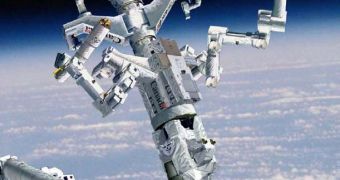Engineering teams conducted a series of experiments with a robotic arm aboard the International Space Station (ISS) last week, in a bid to determine whether the instrument is ready to handle a Japanese cargo capsule that will be launched in January. The assessments were passed with flying colors.
The Special Purpose Dexterous Manipulator (SPDM), which is also known as Dextre, is a two-arm robot that is capable of conducting a variety of tasks on the orbital outpost, such as for example grappling large payloads and depositing them elsewhere.
This is precisely what it will need to do once the Japan Aerospace Exploration Agency (JAXA) launches a new HII Transfer Vehicle (HTV) to the ISS. The unmanned space capsule will deliver supplies and other cargo to the six-member crew of Expedition 26.
Due to the fact that the Japanese spacecraft cannot dock to the station autonomously, like the Russian-built Soyuz and Progress capsules can, a special type of operations is required.
As the capsule approaches the ISS, it will come within a very short distance from the orbital outpost. When this happens, astronauts will need to use Dextre to grapple the spacecraft.
They will then have to move it to a docking berth. For all intents and purposes, Dextre will act like a giant hand, which will take the HTV and place it in its correct configuration, Space reports.
Needless to say, this is a very complex maneuver, and so engineers at the Canadian Space Agency (CSA) – the organization that built Dextre – conducted a series of experiments to ensure that the 2008 addition to the ISS is in good working condition.
On December 22-23, astronauts on the station used the robotic arm to transport a cargo container from one storage location on the exterior of the orbital lab to another, demonstrating many of Dextre's functions in the process.
The tests were conducted by both Expedition 26 astronauts and Canadian engineering teams on the ground. When the cargo container was moved to its new storage platform, it was aligned with great precision, within one degree of perfection.
“We're operating a new robot via remote control, doing a task that has never been done robotically, with precision levels that have to be near-perfect,” explains expert Tim Braithwaite.
“So this test is also about gaining experience for the ground team and learning how to operate Dextre's complicated systems,” adds the official, who is the CSA representative at the NASA Johnson Space Center, in Houston, Texas.
With the new tests completed, ISS managers are convinced the robot will have no problems handling the Alpha Magnetic Spectrometer (AMS), which is due to fly to the ISS aboard space shuttle Endeavor in April.
The AMS is the largest experiment ever flown to space, and Dextre will be needed to move it around.

 14 DAY TRIAL //
14 DAY TRIAL //